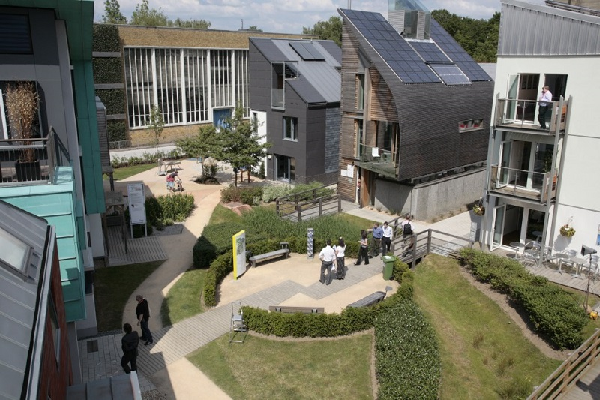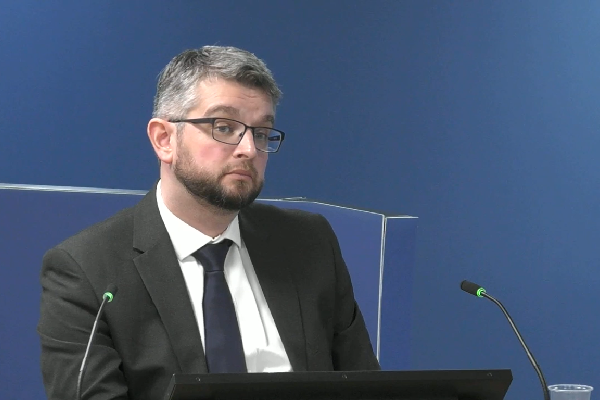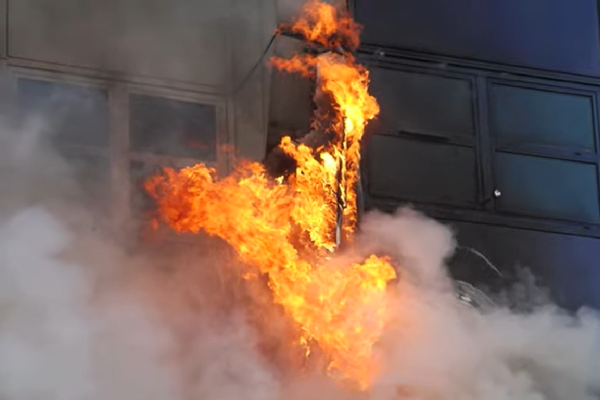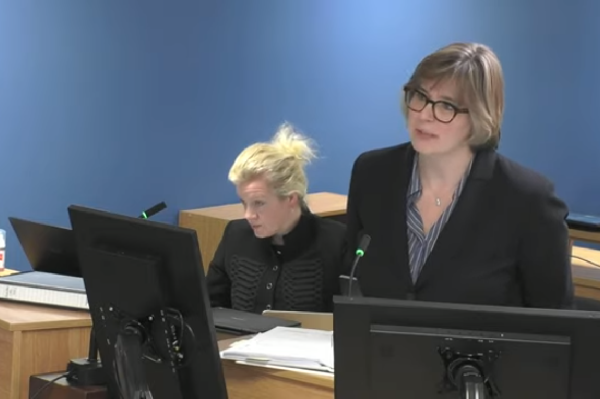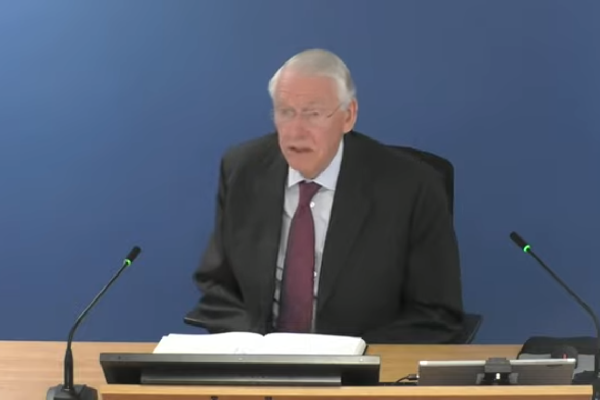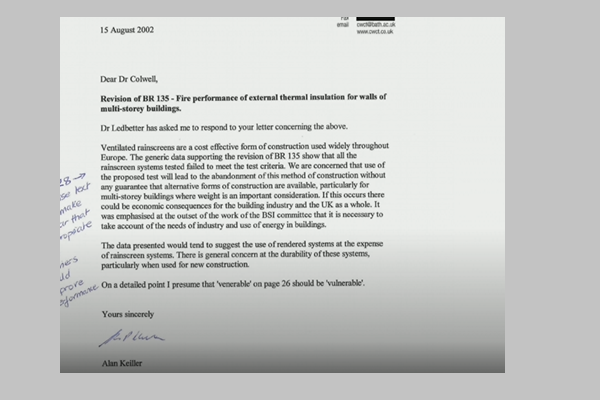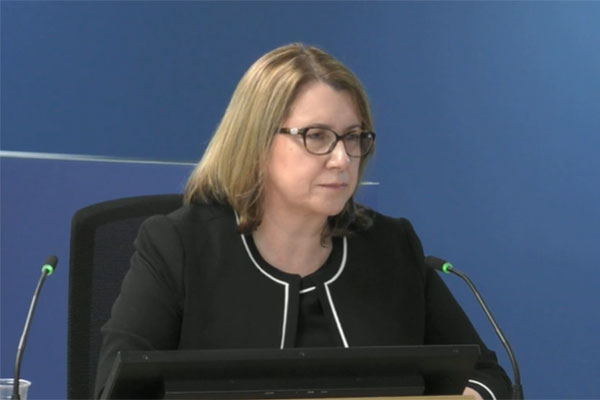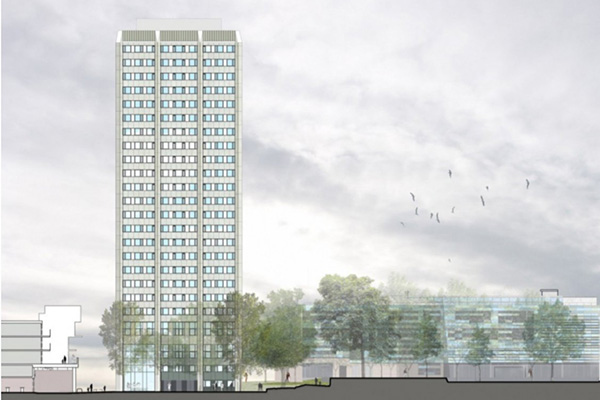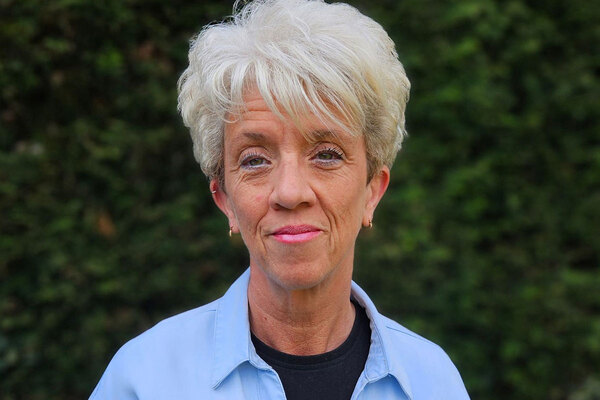Grenfell Tower Inquiry diary week 63: ‘It came after the general move towards deregulation. So more regulation was not welcome’
The government’s focus on deregulation before the Grenfell Tower fire was placed in the spotlight this week with a series of shocking revelations about its failure to amend fire safety guidance. Peter Apps and Grainne Cuffe report
The Grenfell Tower Inquiry’s investigation of the actions of central government stepped up a notch this week, with a series of shocking revelations relating to the work of the Building Research Establishment (BRE) and a failure to act on a devastatingly prescient warning in the years before the blaze.
We will start our recap with the work of the BRE.
‘Do you think it’s right that the findings from hundreds and hundreds and hundreds of fires actually reaffirmed the overall effectiveness of the building regulations?’
The BRE is a grand and historic institution of the UK built environment sector. Initially formed in the aftermath of World War I to provide the scientific underpinning for the Homes for Heroes drive, its research and testing into the science of buildings has underpinned our policies for more than a century.
But in 1997, it ceased to be a part of the British state and was privatised – becoming a not-for-profit trust reliant on commercial income and winning government contracts.
We have already had extensive evidence about its involvement in testing the combustible insulation products ultimately used on Grenfell Tower.
But this week, we looked at something different: the research it carried out for government to inform its fire safety regulations.
In particular, the focus was on its Investigation of Real Fires project. This work, which had run since 1988, and was described as effectively a “watching brief” to monitor real fires to see if any demonstrated evidence that regulations or guidance needed to change.
Dr David Crowder, the former head of fire investigation at the BRE, who worked on the project from 2006 and led it from 2015, explained that the project mainly involved online monitoring of media reports and incident updates from fire and rescue services which would then be summarised for government.
Curiously though, the BRE rarely seemed to find much to improve about regulations.
In fact, in every year-end report for 14 years, they cut and pasted the same conclusion: “The findings from this period have reaffirmed the overall effectiveness of the building regulations and [fire safety guidance] Approved Document B in providing for the safety of life in the event of fire.”
“Do you think it’s right that over that 14−year period, the findings from these investigations, covering hundreds and hundreds and hundreds of fires, actually reaffirmed the overall effectiveness of the building regulations and Approved Document B in providing for life safety? Do you think that’s likely to be correct?” asked counsel to the inquiry Kate Grange QC.
Mr Crowder said the statement was only intended to provide assurance that the BRE did not see the need for a “total rewrite” of building regulations, and more specific issues were raised individually.
But the power to do even this was set to be curtailed.
‘It came after the general move towards deregulation. So more regulation was not welcome’
In October 2012, the BRE agreed a new contract with government to continue this work. But the terms changed.
In the new contract, the government insisted that future reports should “not contain any policy recommendations” or proposed revisions to guidance. This could now only be done at the specific request of government in a dedicated policy report.
Mr Crowder said he believed there had been “unhappiness” about a prior recommendation, although he could not remember the specifics. “It came after the general move towards deregulation. So more regulation was not welcome,” he said.
The coalition government was at this stage engaged in its ‘red tape challenge’, and was promising to remove twice as many regulations as it imposed. Prime minister David Cameron had declared an intention to “kill health and safety culture”.
“Did anybody point out that the objective not to make any policy recommendations was potentially directly in conflict with that stated objective of the project?” asked Ms Grange.
Mr Crowder said he could not remember. He said that the BRE could try and “signal without making recommendations” that there were issues that needed attention.
But he said he felt “hobbled” by this limit. “It goes back to the wider piece about the state of government research in relation to fire safety,” he said. “It was part of… the atmosphere, if you like, around where fire safety under building regulations was going at that time.”
‘Did you ever consider that it might be dangerous to continue with this project?’
The project also suffered from funding restrictions. Mr Crowder said the budget was around £100,000 per year – which left them only able to visit the site of eight fires per year and unable to even secure photographs of many of the fires they investigated.
He described the project as “cut to the bone” and said that when a government official suggested taking an additional 20% off, “I laughed at him down the phone”.
“Did you ever consider that it might be dangerous to continue with this project… without mentioning to government that the constraints of the budget were such that, in fact, proper assessments couldn’t be made?” asked Ms Grange.
“We were trying to do our best with what we had because the alternative wasn’t going to be more money, it was going to be, well, let’s just cancel the contract,” said Mr Crowder.
The inquiry looked into two fires the project investigated in particular detail: Sudbury House in Wandsworth, south London, in August 2010, and Taplow House in Camden, north London, in January 2012.
These were significant, because both buildings contained the same polyethylene-cored aluminium composite material (ACM) cladding later used on Grenfell Tower and represented an opportunity to identify that this product was in wide use in the UK.
But the BRE’s reports contained only minimal summaries of both fires, with no consideration given to the composition of the cladding or potential implications to building regulations.
In the case of Sudbury, a YouTube video, available below, which showed the beginnings of upward and downward fire spread in the cladding before it was extinguished, was not seen by the BRE despite being posted on the day of the fire.
“Do you accept that with hindsight… the reality is that the BRE did not conduct its initial investigation into this fire thoroughly enough to identify the fact that these fires had serious implications for the building regulations and the associated guidance?” asked Ms Grange.
“I would respond that [BRE] conducted its investigation in accordance with the parameters set out and the information available. With hindsight, yes, more should have been discovered, but that is with the benefit of hindsight,” replied Mr Crowder.
He also accepted that the BRE did not generally investigate international fires through this project, saying that the government believed “international fires would not provide useful information” as regulations differed overseas.
Asked specifically about a series of ACM fires in the Middle East in the 2010s, he said: “There was a belief that these fires wouldn’t occur in the UK because ACM wasn’t being installed in the UK. I mean, that’s obviously wrong, but that was the view at the time.”
‘I’m satisfied that there will be no need for you to revisit Lakanal House’
On 3 July 2009, a blaze at Lakanal House in south London killed six people. As we now know, this presented a major opportunity to identify the same weaknesses that led to the Grenfell Tower tragedy.
The BRE’s team began investigating immediately after the fire. They visited the site and carried out some preliminary investigations, delivering an initial report to Brian Martin, the senior civil servant in charge of building regulations, on 16 July.
Concerns were raised about the external spread of fire – including downwards spread. This was significant, because downward fire spread was not an issue provided for in building guidance.
But Mr Martin did not see the need for the BRE’s work to continue. “For the purposes of the fire investigation contract you have with the department, I’m satisfied that there will be no need for you to revisit Lakanal House,” he wrote on 28 July. He said his colleagues were “happy for you to step away” from the project.
“Is it fair to say, you were disappointed to receive this email shutting down the investigation?” asked Ms Grange (pictured above).
“Yes,” replied Mr Crowder. He said he did not know why the investigation had been wrapped up.
Further emails from Mr Martin from 14 July show that he had already come to the belief that the fire would not result in the “need for changes to [Approved Document B]”.
“Can you help us with how Brian Martin could have come to the view just 11 days after the fire that there would be no need for changes to Approved Document B. Can you shed any light on that for us?” asked Ms Grange.
Mr Crowder said that he was “aware there were discussions that were ongoing” but he was “not party to them”.
He would go on to investigate the fire for the police, but said the Department for Communities and Local Government (DCLG) had little interest once they learned the panels on the exterior of the building did not comply with guidance.
“There was clearly a lot wrong with the building, it was non-compliant in lots of different ways,” said Mr Crowder. “Therefore, [Mr Martin felt] it is not a problem with the guidance as such, it’s that people haven’t followed it.”
‘I knew about the government’s Red Tape Challenge at the time’
The issue of external fire spread, though, did not go away. The coroner who ultimately investigated Lakanal House specifically raised the issue.
So did an All Party Parliamentary Group on Fire Safety, who repeatedly pushed government ministers to introduce tougher measures for external walls.
This, Mr Crowder said, led to the BRE being commissioned to research the issue with an article summarising this research ultimately published in April 2016.
The article concluded that there was no major need for changes to regulations or guidance. “With the exception of one or two unfortunate but rare cases, there is currently no evidence from these investigations to suggest that the current recommendations… are failing in their purpose,” it said.
But this week, Mr Crowder described this report as “flawed” and “should be seen in the context of the extremely limited resources in terms of budget, people and time that were available”.
In particular, he accepted that the report could be read as containing a “false assertion” that ‘Class 0’ – the performance criteria for external surfaces of walls in Approved Document B – was adequate.
Mr Crowder said the report was written in the knowledge that the government did not want to toughen regulations.
“I knew about the government’s Red Tape Challenge at the time,” said Mr Crowder. “Everything in Approved Document B is there for securing life safety. The government policy of ‘one in, two out’ and so on meant very difficult decisions would have to be made. If you’re going to introduce something new, something else was going to have to go and that’s not something anyone wants to have to do.”
Sir Martin Moore-Bick, chair of the inquiry (pictured above), asked: “I have to say I find that puzzling. Isn’t it the task of the advisor to tell the government what needs to be done… and leave them to get on with it?”
“Don’t get me wrong, the work was done and the findings were provided. It’s just that I understood the parameters that were sitting around that,” said Mr Crowder.
‘There’s going to be a major fire’
This issue of Class 0 ties into the second major story of the week.
Early in his evidence, Mr Crowder said he had given evidence to the Supreme Court of Singapore (where it is also used) in 2015 that it was not appropriate. “I don’t support Class 0 as a test,” he said. “I understand that there are political motivations as to why it was retained, but those are political, they’re not technical.”
The issue, he said, was that the standard, which primarily considered the spread of flame over the surface of an object, was not a good test for composite products – where the surface may be metal but the core was highly combustible.
He said Mr Martin did not support the use of the classification either.
“I remember being told there were, you know, industry interests − products that were on the market as a result of achieving Class 0 that would cease to be on the market if [it] ceased to be a viable option,” he said.
On Tuesday, we heard from another witness – David Metcalfe, director of the Centre for Window and Cladding Technology (CWCT) (pictured above), about a very clear warning on this point.
In July 2014, the CWCT held a fire safety meeting attended by Mr Martin, Dr Sarah Colwell, a colleague of Mr Crowder’s at the BRE, and various other industry figures.
At the meeting, the issue of Class 0 was raised – specifically in relation to ACM.
The minutes record the statement that ACM products which claimed to achieve Class 0 were being widely used in the UK – making a repeat of the huge fires in the Middle East a possibility.
But Dr Colwell claimed this shouldn’t be happening. She said Approved Document B banned the use of such combustible cladding by virtue of a paragraph which required insulation to meet the higher standard of ‘limited combustibility’.
This was not clear, though – ACM is not insulation. “We were surprised to hear what Sarah Colwell had to say, and we would have certainly questioned how [she] reached that conclusion because it didn’t seem logical to us,” he said.
“We were being offered in an interpretation or a view that didn’t appear consistent with what was written [in Approved Document B].”
Mr Martin had left the meeting by this point, but Dr Colwell said she would draft a ‘frequently asked question’ for his approval setting out that the material was banned.
The inquiry saw evidence that Mr Martin may have been concerned by what he heard at the meeting. One witness statement, shown this week, said that as he left he commented: “There’s going to be a major fire.”
‘There’s a 10-year legacy of misunderstanding by the UK construction industry – what are the life safety implications of that?’
Mr Metcalfe told the inquiry he expected the FAQ to arrive “within weeks”. However, it did not appear.
In September, the CWCT attended a meeting with Dr Colwell to help draft it.
By March 2015, no draft had been provided and Mr Metcalfe emailed Dr Colwell for an update. She responded saying it had been “drafted and revisited” and would “hopefully be closed out soon”.
The inquiry then heard that Mr Metcalfe continued to chase Dr Colwell for an update – sending five emails, plus several phone calls and voicemails through to November 2015. She did not respond.
In March 2016, a further meeting was held, with Mr Martin again in attendance.
Minutes record that he told the meeting that Approved Document B was intended to ban the use of combustible cladding due to the phrase “filler material” in the section on insulation.
This was supposed to be a “catch-all” term, he said, meaning all materials in the external wall should have met the standard of limited combustibility.
Mr Metcalfe said the clause was “poorly written” and “misleading”, but said he was still “content” to follow the government’s interpretation going forward. CWCT published advice to its members in April 2017 saying that cladding panels should meet the standard of limited combustibility.
But still, there was nothing official from government. And no one seemed to be asking the question: if this has been misunderstood for so long, what about all the dangerous buildings out there?
“No one thought to… ask themselves the question, well… there’s a 10-year legacy of misunderstanding by the UK construction industry – what are the life safety implications of that?” asked Richard Millett QC, counsel to the inquiry (pictured above).
“I don’t know,” replied Mr Metcalfe.
The timing of all this is particularly pertinent as the decision to clad Grenfell Tower with ACM was made in summer 2014. A prompt warning from government may have made a difference.
The government has insisted since the fire that its guidance banned ACM.
We also saw last week that after the fire, Mr Martin sought “independent experts” to “state publicly” that the use of the word ‘filler’ effectively banned ACM. This week, further emails showed him approaching the BRE with the same request.
‘If this occurs there could be economic consequences for the building industry and the UK as a whole’
There were also questions over the CWCT’s actions.
The inquiry has already heard that cladding tests in the early 2000s showed rainscreen systems, of the kind later used on Grenfell, failing drastically.
This included one with Class 0-rated ACM, which suffered a particularly drastic failure. So why didn’t the government immediately revoke the Class 0 standard?
This week, the government released a letter (pictured above) from the CWCT apparently lobbying against such a move.
In 2002, following the tests, it wrote to Dr Colwell warning that it was “concerned that use of the proposed test will lead to the abandonment of this method of construction [rainscreen cladding]”. “If this occurs there could be economic consequences for the building industry and the UK as a whole,” the letter read.
Asked about the letter, Mr Metcalfe said it was written before he joined the organisation.
The CWCT is an industry body supported by around 350 companies, which the inquiry heard has a two-tiered system of membership that allows higher fee-paying “sponsors” to “buy the right” to sit on its technical committees.
What was their view of changes to regulations that could limit the sales of their products? After all, it did not clarify that Class 0 products should not be used until three years after the initial meeting and emails show it insisting a Class 0 cladding product could be used shortly after the session.
“Was the CWCT ever placed under any pressure from its sponsors or members not to make this clarification by way of published guidance?” asked Mr Millett.
“No,” replied Mr Metcalfe.
‘The decision to assess the BRE in 2021 was prompted by an article in Inside Housing’
On Monday, we heard evidence about investigations into the BRE after the Grenfell fire.
The United Kingdom Accreditation Service (UKAS), which regulates the BRE, learned through an Inside Housing report of the inquiry that a test carried out on Kingspan’s K15 insulation in 2005 had been withdrawn because it “was not representative of the K15 product which has been sold by them from 2006 onwards”.
This test had been crucial in Kingspan’s claims that its product was suitable for use on high-rise buildings, but had in fact been carried out on a legacy version of the combustible insulation.
UKAS prepared a report reached “fairly damning conclusions” about the organisation, identifying failings that “may be grounds for either partial or full suspension” if repeated in a further assessment.
When questioned, Lorraine Turner, accreditation director at UKAS (pictured above), agreed that it “appeared to be the case” that the BRE had not learned lessons from the past.
But the inquiry also heard that the report was later amended, without the input of the original assessor, to be more favourable to the BRE after it complained, in a step which was described as “appeasing” the influential testing house.
In the end both reports were withdrawn as UKAS was intending to carry out another surveillance visit of BRE in the near future, and also because the first did not include improvement actions and the second “could not stand” without the input of the lead assessor.
The inquiry continues, with evidence from Ms Colwell beginning on Monday.
Grenfell Tower Inquiry week 63: headlines
Government 'shut down' investigation into Lakanal House fire less than a month after deadly blaze
The government discontinued an investigation into a deadly 2009 high rise fire after less than a month and before crucial questions about the reason for the rapid fire spread had been answered, emails released by the Grenfell Tower Inquiry today revealed.
Government contractually prohibited fire investigation group from recommending policy changes
The government “hobbled” a group it appointed to identify any gaps in regulations revealed by real world fires by contractually prohibting them from recommending any actual changes to regulations, the Grenfell Tower Inquiry heard today.
A senior government official failed to provide “desperately needed” clarification that Grenfell Tower’s highly combustible cladding should not have been used on high rises, despite multiple warnings in the years leading to the blaze that existing guidance was not clear.
Testing regulator wrote 'damning' report of BRE after Grenfell inquiry revelations
The UK’s regulator for testing and accreditation wrote a “fairly damning” report of the Building Research Establishment (BRE) last year, after learning through an Inside Housing report that a key cladding system test carried out by the testing house had been withdrawn.
Grenfell Tower Inquiry phase two: weekly diaries
Module one: the refurbishment
Week one: A vivid picture of a broken industry
After a week of damning revelations at the opening of phase two of the Grenfell Tower Inquiry, Peter Apps recaps the key points
Click here to read the full story
Week two: What is the significance of the immunity application?
Sir Martin Moore-Bick has written to the attorney general requesting protection for those set to give evidence at the Grenfell Tower Inquiry. Peter Apps explains what the move means
Click here to read the full story
Week three: Architects of misfortune
This week saw the lead architects for the Grenfell Tower refurbishment give evidence to the inquiry. Peter Apps runs through the key points
Click here to read the full story
Week four: ‘I didn’t have any perception that it was the monster it’s become’
The architects continued to give evidence this week, outlining a lack of understanding of the fire risk posed by the cladding materials and its design. Nathaniel Barker reports
Click here to read the full story
Week five: ‘No adverse effect in relation to external fire spread’
As the Grenfell Tower Inquiry returns from its long absence, Peter Apps recaps the key points from a week of important evidence from the fire consultants to the refurbishment
Click here to read the full story
Week six: ‘I can’t recall any instance where I discussed the materials with building control’
Nathaniel Barker summarises what we learned from fire engineers Exova, architects Studio E and the early evidence from contractor Rydon
Click here to read the full story
Week seven: ‘I do not think I have ever worked with a contractor operating with this level of nonchalance’
Two key witnesses from contractor Rydon gave evidence this week. Peter Apps recaps some of the key points from a revealing week of evidence
Click here to read the full story
Week eight: ‘It haunts me that it wasn't challenged’
Four witnesses from contractor Rydon gave evidence this week. Lucie Heath recaps what we learned on the last week of evidence before the inquiry breaks for five weeks
Click here to read the full story
Week nine: ‘All I can say is you will be taken out for a very nice meal very soon’
This week the inquiry heard evidence from witnesses at Harley Facades, the sub-contractor responsible for Grenfell Tower’s cladding. Peter Apps recaps the key points
Click here to read the full story
Week 10: ‘As we all know, ACM will be gone rather quickly in a fire!’
As the Grenfell Tower Inquiry entered its 10th week, Jack Simpson recaps the key points from a week of important evidence from the refurbishment’s cladding contractor
Click here to read the full story
Week 11: ‘Did you get the impression Grenfell Tower was a guinea pig for this insulation?’
With witnesses from the cladding subcontractor, the firm which cut the deadly panels to shape and the clerk of works which inspected the job giving evidence this was week full of revelations. Peter Apps recaps the key points
Click here to read the full story
Week 12: ‘Would you accept that was a serious failing on your part?’
With the surveyor who inspected Grenfell Tower for compliance giving evidence, this was a crucial week from the inquiry. Dominic Brady and Peter Apps report
Click here to read the full story
Week 13: ‘Value for money is to be regarded as the key driver for this project’
With consultants to Kensington & Chelsea Tenant Management Organisation (KCTMO) giving evidence, attention at the Grenfell Tower Inquiry turned for this first time to the actions of the TMO and the council. Peter Apps reports
Click here to read the full story
Week 14: ‘Did it not occur to you at this point that your budget was simply too low?’
This week, for the first time in phase two, the inquiry heard from Kensington & Chelsea Tenant Management Organisation, the landlord that oversaw the fatal refurbishment of Grenfell Tower. Lucie Heath reports
Click here to read the full story
Week 15: ‘Have you ever informed the police that you destroyed documents relevant to their investigation?’
Witnesses from the Kensington and Chelsea Tenant Management Organisation (KCTMO) gave evidence for a second week, which began with a shocking revelation about withheld and destroyed evidence. Peter Apps recaps
Click here to read the full story
Week 16: ‘I conclude this was very serious evidence of professional negligence’
This week saw members of Kensington & Chelsea Tenant Management Organisation finish giving evidence, before the inquiry’s expert witnesses took the stand to make some highly critical assessments of the work they had seen before and during the refurbishment of Grenfell Tower. Jack Simpson recaps
Click here to read the full story
Grenfell Tower: a timeline of the refurbishment
Following the conclusion of module one of the Grenfell Inquiry’s second phase, Peter Apps presents a timeline of the key moments during the fatal refurbishment of the west London tower block
Click here to read the full story
Module two: the cladding products
Week 17: ‘It’s hard to make a note about this because we are not clean’
The start of the second module of the Grenfell Tower Inquiry phase two came with some huge revelations about the companies that sold the products used in the cladding system. Peter Apps reports
Click here to read the full story
Week 18: ‘It was just reckless optimism wasn't it?’
As the inquiry began cross-examining witnesses for the second module of its phase two work, the picture surrounding just how Grenfell Tower ended up wrapped in such dangerous materials became a little clearer. Nathaniel Barker was keeping an eye on proceedings
Click here to read the full story
Week 19: ‘And that was intentional, deliberate, dishonest?’
The Grenfell Tower Inquiry this week heard the shocking story of how the insulation manufacturer “manipulated” official testing and marketed its product “dishonestly”. Peter Apps tells the story
Click here to read the full story
Week 20: ‘We were outed by a consultant who we then had to fabricate a story to’
This week the inquiry investigated the actions of Kingspan – the manufacturer of one of the insulation products used in the tower’s cladding system. Dominic Brady reports
Click here to read the full story
Week 21: ‘It’s there in black and white isn't it? We see a complete absence of any consideration of life safety’
The story of insulation giant Kingspan’s testing and marketing of its combustible insulation for high rises was unpacked in minute detail this week. Peter Apps reports
Click here to read the full story
Week 22: ‘All we do is lie in here’
In the third week of evidence from insulation giant Kingspan, the inquiry continued to uncover shocking details about the firm’s behaviour both before and after the Grenfell Tower fire. Lucie Heath reports
Click here to read the full story
Week 23: ‘That would have come as an earthquake to you at the time, would it not?’
This week the inquiry took its deepest dive yet into the inner workings of the cladding manufacturer whose product has been blamed for the terrible spread of fire up Grenfell Tower. Nathaniel Barker reports
Click here to read the full story
Week 24: ‘Do you accept that Test 5B was Arconic's deadly secret’
The president of the firm that made and sold the cladding panels installed on Grenfell Tower was asked to account for the apparent concealment of “disastrous” fire tests on the product this week. Peter Apps reports
Click here to read the full story
Week 25: ‘This is quite an incredible list of omissions and missed instances, isn’t it?’
This week the Grenfell Tower Inquiry heard its first witnesses from the Building Research Establishment (BRE) - the testing house which carried out key fire tests on the Kingspan and Celotex insulation products which were later used on Grenfell Tower. Peter Apps reports.
Click here to read the full story
Week 26: 'You were taking an enormous risk, weren't you?'
Week 26 at the Grenfell Tower Inquiry was a key moment in understanding how dangerous products used on the tower came to be accepted by industry professionals. Dominic Brady reports
Click here to read the full story
Week 27: ‘What will happen if one building made out [of] PE core is in fire and will kill 60 to 70 persons?’
The most explosive evidence this week at the Grenfell Tower Inquiry came from those who did not attend, as the evidence which would have been presented to Arconic witnesses was displayed in their absence. Peter Apps reports
Click here to read the full story
Week 28: ‘This is a serious safety matter’
This week the Grenfell Tower Inquiry zeroed in on the British Board of Agrément, the body that produced “misleading” certificates which inspired trust in both the cladding and insulation used on the tower. Lucie Heath reports
Click here to read the full story
Week 29: ‘Is it true that Kingspan’s position… was to do its best to ensure that science was secretly perverted for financial gain?’
The final week in this section of the Grenfell Tower Inquiry primarily examined the attempts by insulation manufacturer Kingspan to lobby government after the fire. Peter Apps reports
Click here to read the full story
How the products used in Grenfell Tower's cladding system were tested and sold
As the section of the Grenfell Tower Inquiry examining how the products used in the cladding system were tested, marketed and sold comes to a close, Peter Apps summarises what we have learned about each of the products included in the system
Click here to read the full story
Module Three: the management of the tower
Week 30: ‘There is certainly a high probability that in the event of a fire the whole building can become an inferno’
The focus of the inquiry shifted this week to the actions of the social housing providers responsible for maintaining Grenfell Tower. Pete Apps recaps what we learned
Click here to read the full story
Week 31: ‘If we cannot get out people will die’
This week saw the former residents of Grenfell Tower enter the witness box to tell of their experiences attempting to raise complaints with the council and its managing agent. Pete Apps reports
Click here to read the full story
Week 32: ‘Let's hope our luck holds and there isn't a fire’
This week saw the return of the landlord of Grenfell Tower, Kensington and Chelsea Tenant Management Organisation (KCTMO), as senior staff members attempted to explain how vital fire safety protections at the block were allowed to fall into disrepair. Lucie Heath reports
Click here to read the full story
Week 33: ‘Isn't that a serious gap in the scope of a policy meant to safeguard vulnerable people?’
A slightly disjointed week at the Grenfell Tower inquiry saw further evidence from staff at building manager Kensington and Chelsea Tenant Management Organisation (KCTMO) interspersed with the views of a cladding expert. Peter Apps reports
Click here to read the full story
Week 34: ‘Some members of the community are doing their best to spread false information’
Jack Simpson covers all the major revelations from the past week of evidence at the Grenfell Inquiry, including evidence from Laura Johnson, director of housing at the Royal Borough of Kensington and Chelsea.
Click here to read the full story
Week 35: ‘I really didn’t like the champagne’
This week the Grenfell Tower Inquiry saw council witnesses, including former deputy leader Rock Feilding-Mellen and leader Nicholas Paget-Brown, questioned about their role in the story for the first time. Peter Apps reports
Click here to read the full story
Week 36: ‘Is that not a very incurious approach for a fire risk assessor?’
This week the Grenfell Tower Inquiry scrutinised the work of Carl Stokes, the man hired to carry out fire risk assessments for the block. Nathaniel Barker reports
Click here to read the full story
Week 37: ‘In giving that advice, weren’t you acting beyond your knowledge and expertise?’
A curtailed week at the Grenfell Tower Inquiry saw fire risk assessor Carl Stokes grilled over advice he gave regarding the tower’s cladding. Peter Apps reports
Click here to read the full story
Week 38: ‘Well it’s a bit more than that, isn’t it. He’s suggesting that you tell the LFB a lie’
The inquiry heard the mammoth cross-examination of KCTMO’s health and safety manager Janice Wray this week. Peter Apps reports
Click here to read the full story
Week 39: ‘What you said there was a grotesque understatement’
This week the inquiry continued to hear from former employees of Kensington and Chelsea Tenant Management Organisation, as well as two employees from the London Fire Brigade. Lucie Heath reports
Click here to read the full story
Week 40: ‘An exercise in concealment and half-truth’
Former KCTMO chief executive Robert Black gave his evidence to the inquiry this week and was asked to account for the various failures described over the previous six weeks. Peter Apps and Nathaniel Barker report.
Click here to read the full story
Week 41: ‘We should do nothing. This is not the sort of website we should be responding to’
This week saw the return of Robert Black, chief executive of Kensington and Chelsea Tenant Management Organisation (KCTMO), before the inquiry turned its attention to the defective smoke control system in the tower. Dominic Brady reports
Click here to read the full story
Week 42:‘They would leak as much as they leaked. They were what they were’
The Grenfell Tower Inquiry continued its in-depth investigation of the tower’s non-compliant smoke control system this week, with evidence from the various contractors involved in delivering it. Pete Apps reports
Click here to read the full story
Week 43:‘Contractors at the time were not generally aware of the importance of leaving holes unsealed’
This week the inquiry focused on two of the more overlooked areas of the Grenfell Tower fire, with evidence focusing on the gas pipelines and lifts within the west London block. It was a packed week, with five witnesses giving evidence. Jack Simpson reports
Click here to read the full story
Week 44:‘I've never seen a fully compliant firefighting lift in any local authority building, to this day actually’
This week the inquiry turn the focus onto the building’s defective lifts, with evidence from an expert, contractors who worked on them and a former engineer at KCTMO. Pete Apps reports.
Click here to read the full story
Week 45: ‘Don’t you find all this rather a surprising debate, given that the Equality Act was passed in 2010?’
The inquiry heard from expert witness Colin Todd this week, who gave his views about the work of risk assessor Carl Stokes as well as answered questions about his own guidance. Peter Apps and Nathaniel Barker report
Click here to read the full story
Week 46: ‘I think I've been very, very clear that is completely wrong’
This week the inquiry heard further expert evidence about fire risk assessor Carl Stokes’ actions, as the section of its work covering the management and maintenance of the tower concluded. Peter Apps reports
Click here to read the full story
Six key failures in the way Grenfell Tower was managed before the fire
Peter Apps recaps some of what we have learned about the actions of the Royal Borough of Kensington and Chelsea (RBKC) and Kensington and Chelsea Tenant Management Organisation (KCTMO) in the years before the fire.
Module one and two closing statements
Week 47: ‘An unedifying spectacle’
After a week of closing statements from the core participants involved in modules one and two, Lucie Heath recaps the key arguments of each group
Click here to read the full story
Module five: the fire brigade
Week 48: ‘They knew, and lives could and should have been saved’
The phase of the Grenfell Tower Inquiry examining the actions of the London Fire Brigade in the years before the fire kicked off this week with some major revelations. Peter Apps reports
Click here to read the full story
Week 49: ‘I'm not sure we've always taken every opportunity to learn as an organisation’
How the London Fire Brigade acted upon lessons from incidents in the years before the Grenfell Tower disaster came under the microscope this week at the public inquiry. Nathaniel Barker reports
Click here to read the full story
Week 50: ‘There is a culture in LFB that is very conservative. I think there is great comfort in what is familiar’
This week the inquiry heard how the London Fire Brigade (LFB) elected not to issue warnings about dangerous cladding before Grenfell and a detailed examination of its policy for checking high risk buildings. Pete Apps reports.
Click here to read the full story
Week 51:‘We teach firefighters to expect building failure’
An unusually brief week of evidence at the Grenfell Tower Inquiry explored how a fire service neighbouring London was taking a different approach to tackling blazes in high rises. Nathaniel Barker reports
Click here to read the full story
Week 52: ‘I actually think that there is a measure of incompetence at all levels’
Expert evidence concluded the current section of the inquiry with some stinging criticism of the London Fire Brigade (LFB). Pete Apps and Grainne Cuffe report.
Click here to read the full story
Module six: fire services
Week 53: ‘They make for chilling reading and harrowing listening’
The inquiry’s investigation into central government began this week with lawyers setting out their view on how and why firefighting policies failed. Peter Apps and Lucie Heath report
Click here to read the full story
Week 54: ‘Our consideration of evacuation at this time was something of a blind spot’
The development of policy on ‘stay put’, both nationally and for London, occupied the attention of the inquiry this week. Peter Apps reports
Click here to read the full story
Week 55: ‘My review is pretty scathing!’
In a week that included the 200th day of evidence in phase two of the inquiry, attention turned to the London Fire Brigade’s control room. Lucie Heath reports
Click here to read the full story
Week 56: ‘Why didn't we thump the table harder’
This week, the control room at the London Fire Brigade was examined further – both before and after the fire. Pete Apps and Lucie Heath report
Click here to read the full story
Week 57: ‘It was worse than slow, it was sluggish’
Former London Fire Brigade (LFB) commissioner Dany Cotton was the star witness this week, as the inquiry continued to delve into the brigade’s knowledge and training before the Grenfell Tower fire. Jack Simpson, Grainne Cuffe and Pete Apps report
Click here to read the full story
Week 58: ‘I don't think we deserve to ask for trust until we demonstrate different outcomes’
A current and former commissioner of the London Fire Brigade (LFB) wrapped up the inquiry’s investigation into the actions of the brigade before the fire. Grainne Cuffe and Peter Apps report.
Module six: testing and government
One of the major scandals of our time: key revelations as the Grenfell Tower Inquiry turns to government
The government was accused of “covering up” the risks of dangerous cladding as its “unbridled passion for deregulation” left it a “junior party” to the construction industry as the latest phase of the public inquiry opened today. Peter Apps summarises some of the main points
Click here to read the full story
Week 59: ‘Recent tests have apparently shown it continued to burn for 20 minutes after the flame was taken away’
After shocking opening statements, the Grenfell Tower Inquiry turned its attention to the work of Local Authority Building Control. Pete Apps reports
Click here to read the full story
Week 60: ‘You could have an exact repeat of the Dubai fire in any number of buildings in London’
The Grenfell Tower Inquiry turned its attention to the work of the National House Building Council this week, with shocking revelations about the extent of the warnings issued to central government before the fire. Peter Apps reports
Click here to read the full story
Week 61: ‘Mistakes are meant for learning, not repeating’
In the first hearings of the new year, the Grenfell Tower Inquiry heard closing statements from the firefighting section of phase two. Lucie Heath reports
Click here to read the full story
Week 62: Did it ever occur to you that this act of collaboration was, in one sense, corrupting?
The Grenfell Tower Inquiry returned to the work of the National House Building Council (NHBC) this week, with a new shocking revelation about the government’s actions in the immediate aftermath of the fire. Peter Apps reports
Click here to read the full story
Week 63: ‘It came after the general move to deregulation. So more regulation was not welcome’
The government’s focus on deregulation before the Grenfell Tower fire was placed in the spotlight this week with a series of shocking revelations about its failure to amend fire safety guidance. Pete Apps and Grainne Cuffe report
Click here to read the full story
Week 64: ‘I didn’t think ACM would be suitable for use in any high-rise buildings. I don’t think anyone did’
This week, the Building Research Establishment’s Dr Sarah Colwell gave more than three days of evidence, with some huge revelations about what was known about the dangers of aluminium composite material years before the fire and the mass confusion over the government’s building regulations. Peter Apps and Jack Simpson report
Click here to read the full story
Week 65: ‘Unless the government does something now about ACM panels, people will die’
Further evidence from the Building Research Establishment and the first government witnesses added new depth to our understanding of how warnings were missed before the Grenfell Tower fire. Peter Apps reports
Click here to read the full story
Week 66: ‘Was there a cover-up?’
The latest evidence from the Grenfell Tower Inquiry tracked the government’s failure to act on fire safety warnings right up until the months before the fire. Peter Apps and Grainne Cuffe report
Click here to read the full story
Week 67: ‘When exposed to a fire, the aluminium melts away and exposes the polyethylene. Whoosh!’
This week the inquiry heard disturbing new evidence about the failure of senior government officials to act on warnings about dangerous cladding in the years before the Grenfell Tower fire. Peter Apps reports
Click here to read the full story
Week 68: ‘Can we agree that was a pretty dangerous thing to have, all this falling on one man’s shoulders?’
Three senior civil servants gave evidence this week, including the official who had responsibility for building regulations guidance on fire safety in the years before Grenfell. Peter Apps, Lucie Heath, Stephen Delahunty and Grainne Cuffe report
Click here to read the full story
Week 69: ‘It was just unthinkable. You had the makings here of a crisis you could not comprehend’
This week, civil servant Brian Martin gave his long-awaited evidence to the Grenfell Tower Inquiry. Peter Apps reports
Click here to read the full story
Week 70: ‘Show me the bodies’
An important week at the Grenfell Tower Inquiry saw a dramatic conclusion to the mammoth cross-examination of civil servant Brian Martin, as well as the first politicians. Peter Apps and Lucie Heath report
Click here to read the full story
Week 71: ‘I have changed my schedule to fit this in. I do have an extremely busy day meeting people’
Three politicians who were responsible for building regulations before Grenfell appeared before the inquiry this week, including the former communities secretary Eric Pickles, who responded to the coroner’s letter following the Lakanal House fire. Peter Apps and Lucie Heath report
Click here to read the full story
Module Four: aftermath
Week 72: 'The system isn't broken. It was built this way'
This week the inquiry turned to the shocking story of the lack of support for bereaved and survivors in the immediate aftermath of the Grenfell Tower fire. Peter Apps, Lucie Heath, Grainne Cuffe and Jack Simpson report
Click here to read the full story
Week 73: ‘Most people would regard that as hopeless’
This week, the Grenfell Tower Inquiry heard about the Royal Borough of Kensington and Chelsea’s chaotic response in the immediate aftermath of the blaze, from the staff responsible for it. Pete Apps, Stephen Delahunty and Grainne Cuffe report
Click here to read the full story
Week 74: ‘Do you agree that RBKC was ill-prepared and incapable to meet its duties’
This week, Nicholas Holgate, former chief executive of the Royal Borough of Kensington and Chelsea, was grilled on his failure to hand over control of the aftermath of the fire, despite the borough’s lack of capacity. Peter Apps reports
Click here to read the full story
Week 75: ‘It still shocks me to the core that that’s how we treat our citizens in this country’
This week the inquiry heard witnesses from the housing management body discuss their role in the aftermath of the Grenfell Tower fire, followed by a range of witnesses from other organisations which supported the response. Peter Apps and Grainne Cuffe report
Click here to read the full story
Week 76: ‘I fear this will become our New Orleans’
This week the inquiry heard from central government figures and members of the London-wide emergency response arrangements. Peter Apps and Grainne Cuffe report
Click here to read the full story
Week 77: ‘The planning wasn’t done and there was nothing for us to be drawing on’
The Grenfell Tower Inquiry’s examination of the aftermath of the fire concluded with witnesses from central government. Peter Apps reports
Click here to read the full story
Module seven: expert evidence and closing statements
Week 78: ‘The abandonment of the ‘stay put’ strategy for high-rise residential buildings is essential’
This week the Grenfell Tower Inquiry heard a range of expert witnesses discuss their reports. Peter Apps and Grainne Cuffe report
Click here to read the full story
Week 79: ‘You could argue the system was created to enable people to circumvent the rules’
The Grenfell Tower Inquiry continued to hear expert evidence this week, with two senior figures in the world of fire safety academia criticising the government’s approach before and after the blaze. Peter Apps and Grainne Cuffe report
Click here to read the full story
Week 80: ‘The evidence points to wilful blindness and complacency towards safety’
As the inquiry moves into its final stages, lawyers for the key players gave statements about the evidence surrounding central government. Peter Apps reports
Click here to read the full story
Week 81: ‘This is Islamophobia. It’s racism. It is the elephant staring back at us in the room’
This week, closing statements covering the aftermath of the fire delivered a shocking new revelation and an expert toxicologist gave his views on the causes of the deaths. Peter Apps reports
Click here to read the full story
Module eight: further evidence relating to the deceased
Week 82: ‘Their chance to hear about the circumstances in which their loved ones died is the culmination of five years of waiting’
The Grenfell Tower Inquiry moved into its final module this week, with evidence relating to the circumstances in which the victims died. Peter Apps reports
Click here to read the full story
Week 83: ‘They died together as they lived: caring for one another’
A second week of evidence relating to the circumstances in which the victims of the fire died delivered more heartbreaking stories about their final moments. Peter Apps recaps
Click here to read the full story
Week 84: ‘Every decision affects someone who is an adored child, a beloved sister, a respected uncle, a needed mother’
The final week of oral evidence for the Grenfell Tower Inquiry’s second phase contained more heartbreaking evidence about the deaths in the tower. Peter Apps reports
Click here to read the full story
Closing statements
Week 85: ‘The merry-go-round turns still, the notes of its melody clearly audible in the last few days’
The Grenfell Tower Inquiry returned this week for closing statements from lawyers representing the bereaved and survivors and the various parties under scrutiny for the fire. Pete Apps reports.

